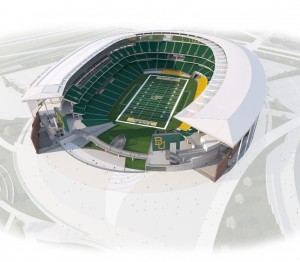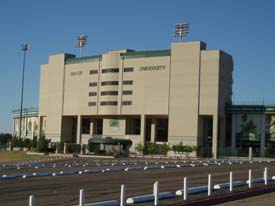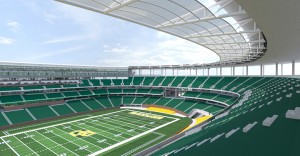![]()

By Linda Wilkins
City Desk Assistant
Construction is under way on the new Baylor Stadium after a $35 million contribution from the Waco City Council passed unanimously.
The first vote took place July 17. Both votes unanimously supported contributing the TIF funds which includes the public contribution.
The Waco City Council voted Aug. 7 during a public hearing to provide the Tax Increment Financing Zone funds to the stadium project, which was the second of two required votes.
According to Dr. Reagan Ramsower, Baylor’s senior vice president for operations and chief financial officer, the TIF funds will be used to build a portion of public infrastructure around the stadium, such as harbors, utilities, parking, bridges, electrical lines and a new marina.
In addition to the Waco City Council votes, the Baylor Regents also voted to move forward with the stadium project, with the condition the Waco City Council approved the funds during the second vote, Ramsower said. The regent vote took place July 19.
In a July 20 press release, Baylor regent chairman Richard Willis said, “The Baylor Stadium complex will be a tremendous asset for both Baylor and the greater Waco community. We’re proud to be partnering with the city in this remarkable project.”
According to Waco Mayor Malcolm Duncan, the TIF funds, begun in 1982, are intended for building public infrastructure. He also said the money for the stadium project is not coming from new taxes; the funds are an accumulation of money from increased property taxes since TIF began.
Ramsower said the contractors for the project are Austin Construction and Flintco, both national firms that have partnered for this project. Local businesses will be used as subcontractors.
“It is very important to Baylor to help the local market,” Ramsower said.
Ramsower said Baylor Stadium will provide economic growth, community space for events and a riverfront view.
Duncan said the new stadium will help generate economic growth.
“It’s the anchor of development on the riverfront corridor,” Duncan said. “It will be the start of many more development projects.”
Since the project’s beginning, the potential economic growth generated from a new stadium was evident, Ramsower said. He said the stadium project is “a major catalyst for downtown and riverfront development.”
“The stadium’s location is going to be a great front porch, not only for Baylor, but for the city and the river,” Ramsower said.
Ramsower explained his vision for the riverwalk by describing the other venues already present.
McLennan Community College, the Waco Mammoth Site, Cameron Park, Brazos Park East,and the Suspension Bridge will be the scenery visitors will see along the riverwalk. Ramsower said the riverwalk will be a highlight once the stadium is built.
He said the project would bring new hotels, restaurants and even movie theaters to the riverfront area. Ramsower said he thinks the new stadium will generate excitement for students, alumni and supporters.
The excitement is not reserved for only Baylor fans but also for the local community.
According to officials, the stadium facilities will also be used year-round for community events.
High school and youth football, soccer, rugby, lacrosse and field hockey are a few of the sporting events that could occur at the stadium, Ramsower said.
During the year, concerts and festivals will also take place and will include events such as Oktoberfest, Balloon Festival and the Central Texas Music Festival. Religious gatherings, banquets, meetings and weddings are also potential community gatherings at the stadium.
Ramsower said a figurative groundbreaking will happen during the football game on Sept. 15 at Floyd Casey Stadium.
The event will celebrate the new stadium and is also meant to thank the Waco community for its support.
A literal groundbreaking is cancelled because of the high temperatures and dusty ground.
The future of Floyd Casey Stadium
There is no permanent solution for what officials are calling Baylor’s “No. 1 deferred maintenance project.” Two years ago Baylor officials considered the possibility of renovating and updating the then 61-year-old stadium, but Ramsowersaid the renovations would have cost an estimated $80 million. Ramsower also said that if a way to repurpose Floyd Casey is not found, the stadium will most likely be demolished.

Floyd Casey Stadium has been the home of the football team since 1950. With construction of the new stadium on the horizon, the question of what will happen to the old stadium is still unanswered. The first game played in the 50,000 seat stadium was Sept. 30, 1950, a 32-7 victory over the Houston Cougars.
Stadium Design
Baylor Stadium will sit on 93 acres of land on the Brazos Riverfront. The stadium design will allow for greater comfort than Floyd Casey, Nicholas Joos, executive associate athletics director for external affairs at Baylor said.
Joos said everyone in attendance would be closer to the field than at Floyd Casey Stadium.
The stadium will contain 45,000 seats and will have 3,000 spaces for standing room only. Joos said 7,000 seats will be reserved for students, with the Baylor Line situated directly behind the opposing team. The student space can be expanded upwards to accommodate as many students as needed.
Ramsower said the student section will be designed to look great on TV.
Like Floyd Casey, the stadium will have bench seating and chairback seating.
To protect against the Texas heat, a canopy will shade 45 to 55 percent of seats during the day.
“The canopy will not give 100 percent shade, but it should add to the enjoyment for all fans,” Joos said. “In September, it’s normally blazing hot and this will give folks more comfort.”
Like Floyd Casey, the field will be made of synthetic material.

Riverfront view and bridge
Joos said, the riverfront location was chosen because of its uniqueness. He said there are not many stadiums situated on a river.
“It’s the opportunity to have a wonderful campus as a backdrop, and that’s very unique,” Joos said.
Because of the riverfront location, Ramsower said ferry services to the stadium might be a possibility. Located at the intersection of I-35 and the Brazos River, 42 million cars pass by that location annually, Ramsower said.
The Umphrey Bridge will be the main access point from campus to the stadium.
Attendants are being encouraged to park on campus and have the opportunity to walk through campus. The administration hopes this will encourage more students to attend Baylor.






